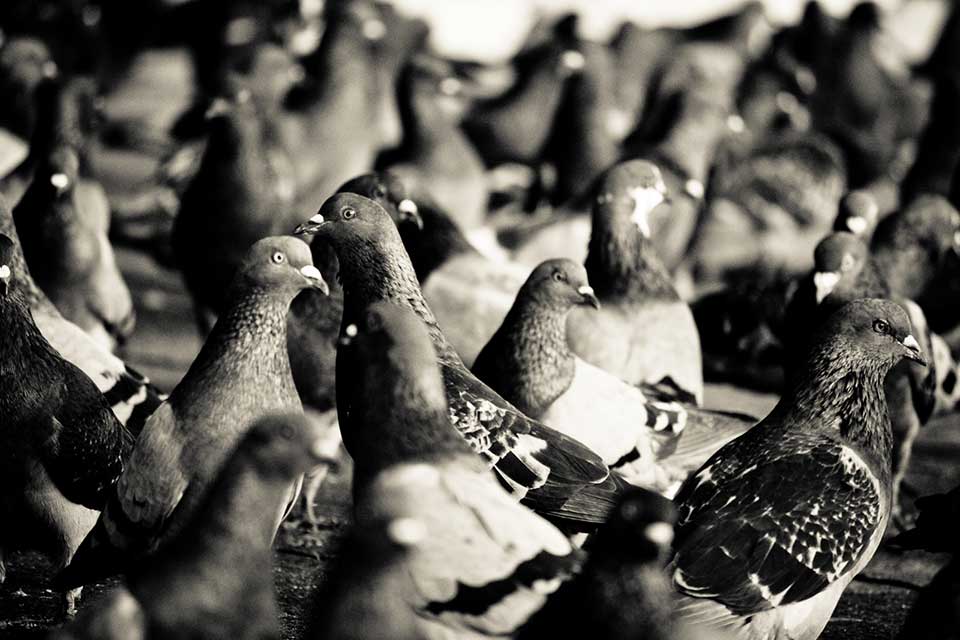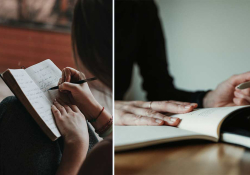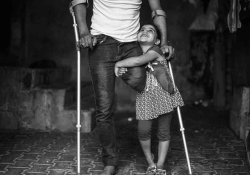In the Hand, a Bag

An artist of stillness, her life a dance of immobility, performs the art of losing in a plaza.
It’s four o’clock in the afternoon, and the show is about to start. People reluctantly gather in that plaza full of pigeons. It would seem they are forced to attend the show. Their faces, somewhat empty of desire, seem jaded.
Only a few watch the surroundings. The sky is an extended piece of blue fabric. A ribbon of ocean decorates the wall surrounding the plaza. The wind rumples curls. The brick pavement shows hundred-year-old grime. Dozens of fat and disgusting pigeons stalk the children who feed them. Some have pustules in the corners of their eyes. The corn disappears instantly from the children’s hands. The old woman tending to them fills the cupped little hands. It’s an automatic movement: they peck voraciously, the old woman pours corn from the bag; they peck voraciously, the old woman pours corn from the bag. The children can’t decide whether they’re frightened or amused. I can tell by the muffled screams disguised as laughter that come out of their mouths. A pigeon foot on a tender shoulder is horrific. To feel the repulsive claw of an insatiable hunger must be nauseating.
To feel the repulsive claw of an insatiable hunger must be nauseating.
The artist is at the center. Just her, a step stool, and a bag firmly attached to her hand in the middle of a makeshift stage of a temporary theater. She must compete with the pigeons. Not an easy task. Those sinister birds are territorial. The plaza has turned into a pleasant shithouse. The birds have taken over the place, the immense tree in the plaza, the sky. If it were still, they would take over the breeze, too. Not that they haven’t tried. Instead, they use it to move about the space.
The performer has arrived an hour early; it’s a matter of discipline. Today she will premiere her most complex piece. No one will know. None of the spectators will commit to paper the colossal effort she is determined to perform. Her art has always gone unnoticed. She ceased to care about the spectators’ indifference a long time ago. That’s when she achieved the perfection of the movement. She knows it very well. The act is for herself. Even better if someone enjoys a fraction of her endeavor, but she doesn’t care anymore.
She is an artist of stillness. She has practiced it for years. She concentrates on abandoning movement. She calls her life the dance of immobility. Her choreography is so limited that it is impressive. Only the attentive eye can notice the minuscule movements. Hands have muscles; we don’t think about that. Sometimes it’s difficult to control their involuntary movements. While she is onstage, she dreams that she is glass, iron, concrete. She doesn’t take up space, but she doesn’t recoil or let go. She folds into herself, the bag she carries seems fixed to her hand. Someone says that a resin of sorts has formed between her hand and that plastic bag. Perhaps because she has never let go of it. Perhaps because that small hand holds the bag with enviable concentration.
Today she felt that she wanted to release the fist. Fully open her hand. Extend her five fingers. She decided that should be the act she would bestow upon the ungrateful spectators this afternoon. She will concentrate on achieving that movement. As the people gathered, curious about her black top hat, her soiled tailcoat, and her resolute pose, she felt her tiny hands didn’t have their usual grip. She had been feeling it for a while, but the time had come to acknowledge it. She intently observes her minuscule extremities. The veins ruin their former elegance. A blue spiderweb runs from the back of her hand to her bony fingers. To be precise, she thinks they are a bouquet of serpents: some are fat, about to explode; others are thin like iridescent threads; others, the happiest, are lost in her skin. There’s no proportion among the thin wrist, the skinny arm, and the robust body to which the extremity is attached. It’s as if the hand couldn’t bear the strength such a body could hold. Maybe that would explain the pain in the trapezius, the collarbone, the shoulder. The pain is such that she no longer feels it. She thinks numbness is her condition. Stretching is difficult. Flexing is torture.
It’s as if the hand couldn’t bear the strength such a body could hold.
The fingers are stiff. The weight they have held all these years is noticeable. For not letting go, she rarely clips her nails. I won’t talk about the accumulated grime in those claws. I rectify: the gunk is the proof of her superhuman effort. It’s an opaque, thick, greasy layer the color of coffee. Some things are better left untold. Why should anyone be interested in the unbearable stench that comes from that hand since the smell naturally settles into the plaza?
Determined to gift away her effort, she will slowly climb the small step stool she has brought. Her choreography proposes twenty minutes to mount it. The climb shouldn’t be rushed, it would ruin her act. She knows that most of the spectators won’t endure her dance. They’ll leave before she has lifted her right foot. She challenges their patience; she focuses on a contained movement. That’s her proposal. As the artist makes her first diminutive move, the sound of the bag is heard. The expectant audience falls silent and decides to keep on watching.
You must learn to let go, she says to herself. You must learn that you lose. But knowing that you lose is an art. She read that a long time ago. It’s the art of disaster. She tries it today with her sad choreography. The only true step is to hold. It doesn’t seem like much, but to her, it’s a huge effort. I clarify: holding up isn’t the same as holding. Holding up shows strength. It’s retaining, retracting, containing. Her entire life is a container.
Small, skinny hands don’t grasp, not for a long time, not a lot. In the bag she carries all the things she deems indispensable. She swears they should always be with her, always. She insists on gripping the concatenation of objects. Clawingly clawed.
The bag is big. It must be very heavy. An immense hodgepodge of shadows inhabits the bag made of recycled material. It’s dirty. It’s been in many places. Although plastic doesn’t absorb sweat, there are stains shaped like waves or maybe tides at the opening. They resemble the rings on a tree trunk. Those that tell how long they have been in the world. Inside the bag there is a bit of everything. A maelstrom of hair, nails, heads, broken bones, preserved scraps of flesh, smiles, guffaws, groans, muffled screams, amplified laughs. There are also scents and odors, sounds and noises, cold and heat. What’s most impressive are the glances. They hardly weigh anything at all, but their consequences are incalculable. Some come from the heads, others from the loose eyes that wander inside the bag. Eyes remember with their heart, the one they had. A guzzler of memories, if the bag were to be opened, the suffocated voices, the grave and relieved sighs, the pointed words would escape.
A guzzler of memories, if the bag were to be opened, the suffocated voices, the grave and relieved sighs, the pointed words would escape.
There are also bodies inside that bag. Maybe in halves, in pieces, in chunks. The body fragments still contain the organism; they are its synecdoche. Their voices have been suffocated, but they still sigh. Daughters and sons. Of all ages. There are old people and children. There are adult women. There are adolescents. Some are twice as old as the artist. Where did she find them? How long have they been with her? How did they get there?
The woman’s foot still hasn’t touched the step stool. It’s about to. One must admire her equilibrium. She is a great artist of stillness. She resembles a sphinx out of place and time. Exposed to the humidity that melts everything. The audience has grown smaller. It’s logical. Who can stand inactivity? If they only knew the things she carries in that filthy bag, they would stay. I bet. Those who stay grow impatient. There are only a few, twenty minutes have lapsed, and the woman isn’t standing on the step stool yet.
She thinks she may not be able to finish the act. She is beginning to doubt her effort. The arch of her foot hurts, it begs for a rest. She agrees. She plants her right foot on the step stool. She leans forward and puts all her weight on the wooden plank. The few spectators that have stayed clap. She still has to lift her left foot. As she is now, she resembles a tired bridge. She feels the weight of the bag in her thin wrist. She almost faints, but she knows she can’t let go of it. Her act would be ruined. After placing her left foot on the step stool, she must raise the bag and open her right fist. When she finally plants the other foot on the step stool, she hears clapping. She stands upright. Her body feels some relief, although she feels a strange sensation. She is standing straight on the step stool in front of the few spectators that remain. She still has to raise her arms and let go of the bag. This is the new step of her dance.
Once on the step stool, the murmuring of the voices inside the bag becomes a noise. The roaring noise escapes through the small opening at the top of the bag. A crowd shouts, curses, demands. She taught them to do so. She wanted to make herself necessary. She wished they wouldn’t abandon her. Better the cries than the silence, she tells herself. She hasn’t carried those bodies all this time in vain. She doesn’t want to let go of the bag just yet. It’s really hard for her. She should have eaten those pieces of flesh, bones, cells, choked on the hair, the eyes, the skin. She regrets it. Now she wouldn’t feel compelled to relax her fist and let the contents of the bag fall down. She attempts the minuscule movement, but the hand’s mechanism doesn’t work. It’s as if the fingers are stuck and won’t let go. She must concentrate to set free the bodies and their fragments, the voices, the eyes and their gazes. Before her dwindling audience leaves, she must let go in order to fatten herself with memories. If she can’t perform that small movement, she will betray her purpose.
Thirty minutes have elapsed. She has overextended the agreed-upon time limit. Her choreography must end. Only two young women remain in the audience. And the pigeons. They have endured her performance with interest. In quiet defiance, their presence challenges her to finish her dance.
“We have all the time in the world,” they shout.
Translation from the Spanish
Editorial note: From Geografías de lo perdido (Ediciones Callejón, 2018).












